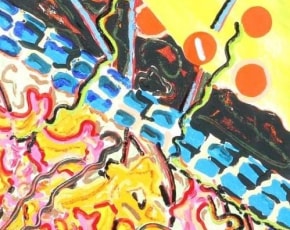
Fracture 1 (1982)
Oil on canvas, 36 ½" x 20 ¼"
Signed "N.S. Graves V-1-82 / o/c / 36-1/2 x 20-1/4" verso on canvas.
Provenance: M. Knoedler & Co, New York, NY & Zurich, Switzerland (Label verso), 1983.
Ripley Modern & Contemporary Art auction, September 26, 2020, Lot 132 (Est. $5-6,000. Sold for $21,250.)
Exhibitions: 1982 "Nancy Graves: Skulpturen und Bilder" M. Knoedler Zurich, Zurich, Switzerland
Verso
Inscribed "N.S. Graves V-1-82 / o/c / 36-1/2 x 20-1/4" verso on canvas.
M. Knoedler Zurich label verso.
“One of the things that people find confusing about her [Graves], and maybe a reason she’s fallen under the radar,” Hunter suggests, “is that she worked in so many media. People got confused, asking, ‘Is this all by the same person?’” Take those early camels, for instance. Sculptures made to look like taxidermy—Graves’s father worked at the Berkshire Museum, which houses natural science adjacent to fine art—they are an intellectual experiment that Nochlin compares to Marcel Duchamp’s 1917 Fountain. (One might wager that Hiroshi Sugimoto took a good look at them before shooting his “Dioramas” series.) Then there are the Graves paintings which take topographical maps (satellite images of the ocean floor and surface of the moon, for instance) and images from nature books (a halibut blending into the sand) as inspiration and wind up as brilliantly hued, layered, abstract musings. Looking at them is like seeing shapes in the clouds. And they couldn’t be more different than the hyperrealist camels.
Binding her disparate oeuvre together is Graves’s fascination with data, translating scientific information into visual wonder. “She sensed she was making art in the ‘information age,’” according to Hunter. “And people like Julie Mehretu have looked very closely at her work.” One can only imagine how Graves would have dealt with Big Data.
Perhaps the other unifying feature of her work is its reactionary stance toward both Minimalism and Pop Art. Graves was unlike anything happening in the art world around her. “She refused to brand herself,” Hunter says. “Some of the topics that have been of great interest in the past several decades—identity politics, feminism, celebrity, sexual deviancy, consumer culture—none of those themes interested her. She lived some of them, and was an absolute feminist, but she didn’t want to be pigeonholed.”
–Christina Hunter, Director of the Nancy Graves Foundation in a Vogue 2015 article
